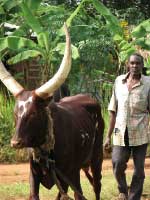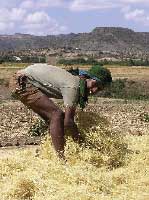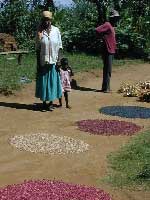Potential Research Areas
Here are several examples of potential research areas that students might focus on.
Water Shortages
Similar to general global trends water shortages in both Ethiopia and Kenya are an increasingly pressing problem that are most acutely felt by the region’s poorest populations.
The poor generally have the worst access to water due both to the entitlement issues as well as their inability to afford technologies that draw water from deep or distant sources. Water scarcity impacts the quality of the remaining water resources, the poor’s ability to produce crop and livestock products and the family’s health and productivity. In Ethiopia, for example, lower agricultural productivity and higher levels of undernourishment and child stunting were found in areas that suffered most from water scarcity.
In the East African context, water scarcity is a function of a variety of factors, including a preponderance of marginal land that receives low and unpredictable rainfall (only 11% of Ethiopia and 7% of Kenya are considered arable) and poorly developed infrastructure for capturing, managing and distributing existing water resources. Reduced water quality and quantity is also a function of increased demand due to growing populations, economic growth and overexploitation of natural resources, particularly in catchment areas, riparian zones, wetlands and other areas that impact the region’s hydrology.
Because agriculture in the region relies almost entirely on rainfall (green water), improving water use efficiency is a key requirement for increasing agricultural productivity. In Ethiopia, for example, more than 90% of the food is produced by green water, yet 50-70% of all rainwater runs off. Developing better means to capture, retain and redistribute rainwater where it is most needed is a scientific challenge of first order importance. Reliable and sustainable water access by the rural poor in the SAT/SHH will not only require better water supply management and rainfall capture, but more comprehensive, integrated systems that combine, for example, drought-tolerant or flood-resistant crops with improved, affordable water storage methods and more effective community and regional water management organizations. While increased water availability is key to increasing productivity, this requires new policies and technologies that do not treat water as an inexhaustible resource. In particular, scientists and policy makers will need to carefully consider investment tradeoffs between blue (irrigation water from river and reservoirs) and green water. The Green Revolution emphasized the use of large reservoirs to store blue water, largely based on technologies (pumps and other machinery) and institutions (credit) and infrastructure available in advanced economies. But this approach has largely failed in the African SAT/SHH where socioeconomic, organizational, hydrogeological and demographic conditions differ from the more favorable natural conditions in the areas where the Green Revolution took hold. Unfortunately, despite the imperative of developing more diverse and effective strategies for improving water availability, most hydrological research in the region still focuses on the development and use of blue water rather than green water’s more efficient and effective use.
Climate Variability
The SAT/SHH are particularly vulnerable to climatic shocks associated with rising temperatures and more unpredictable precipitation patterns, which model predictions currently suggest may increase in both frequency and intensity.
While the number and severity of climate-related natural disasters rose sharply worldwide over the last decade, the biggest rise was in low-income countries, where the incidence of disasters grew at twice the global rate. These disasters are costly. In Kenya, two recent climate-related incidents, the La Nina drought of 1998-2000 and the El Nino Floods of 1997, caused severe economic impacts. In Ethiopia, economic growth is so sensitive to hydrological variability that even a single drought event within a twelve year period (the historical average is actually 3-5 years) decreases average growth rates across the entire 12-year period by 10%. And extreme rainfall variability — especially the experience of drought — appears to give rise to the emergence of poverty traps among migratory pastoralists in the more arid parts of east Africa. The effects of weather-related shocks to food systems and poor people are compounded by less reliable physical and institutional infrastructure for responding to shocks. Recent evidence from drought in Ethiopia and hurricane in Honduras indicates that the medium-term effects of a major weather shock vary by household wealth, with the poor feeling the adverse effects more acutely and for a longer period.
There are many other issues related to climate change. See, for example,the following film (from our partner in Kenya and Ethiopia, the International Livestock Research Institute), which shows how current environmental and climatic changes in Africa, combine with population increase, to trigger both new and old diseases among people and their animals.
Soil and Land Degradation
Widespread poverty in the SAT/SHH is both a cause and effect of soil degradation. A National Research Council publication identified poor soil quality as the primary constraint on agricultural productivity in Sub-Saharan Africa.
Recent estimates show that Sub-Saharan Africa faces what a recent study refers to as “an escalating soil fertility crisis”; the region lost 4.4 million tons of nitrogen, 0.5 million tons of phosphorous, and 3 million tons of potassium between 1980 and 2004, costing the continent more than $4 billion worth of soil nutrients per year. Shrinking landholdings due to population growth, continuous cropping, insecure land tenure and unaffordable fertilizer have resulted in severe soil degradation, diminished crop productivity and incomes, malnutrition and vulnerability to ill health. Without effective interventions to increase soil productivity and cropping system diversity, many farmers and their families are unable to produce enough food to feed their families or to earn adequate incomes. They then resort to the destructive, but perfectly rational exploitation of the surrounding natural resource base, cutting down trees to make charcoal, harvesting and selling meat from wildlife or even converting their own farm soils into clay bricks . In such settings, identifying appropriate and sustainable technologies and effective policy interventions aimed at reversing soil degradation depend on understanding the interlinked economic, social and biophysical dimensions of the problem.
Simple solutions belie underlying complexities. For example, in highly variable rainfall environments, mineral fertilizers are often unprofitable and can greatly increase farmers’ production risks; fertilizer use under low moisture conditions can lead to reduced seed germination, low seedling survival and even crop failure. Moreover, even with adequate water, when the economics of fertilizer application are considered in relation to the soil degradation status of farmers’ land-holdings, fertilizer applications at levels the poorest farmers can afford do not pay for themselves. The integration of legumes into cereal-based production systems can contribute to the productivity and sustainability of cropping systems, while providing much-needed dietary diversity and income supplementation. But several constraints affect the utilization of legumes in tropical cropping systems, including vulnerability to pathogens, pests and weeds (see below). Furthermore, different soils’ responsiveness to different interventions is complex and highly non-linear, often conditioned by the presence or absence of livestock and soil macrofauna and microbial communities that jointly regulate soil nutrient dynamics. While the importance of soil nutrient depletion to poverty reduction and overall economic development in Sub-Saharan Africa was emphasized by the June 2006 international fertilizer summit in Abuja, Nigeria, attended by representatives of 40 African heads of state and governments, systems level understanding of this growing crisis and of appropriate interventions remains distressingly scarce.
Emerging Agricultural Pest and Disease Problems
Pests and diseases cause massive crop and livestock losses and high risk in much of the African SAT/SHH. The consequences of such losses are particularly severe for poor farmers and consumers.
Some types of pest damage are readily apparent, while others are unseen and insidious and often related to other problems or disruptions. For example, as soil quality declines, a parallel decline in crop vigor makes plants more susceptible to abiotic and biotic stresses. Soil-borne pests and diseases thrive under these conditions. In the intensive maize and bean systems in the East African highlands, for example, soilborne bean seedling diseases (caused by Pythium and/or Fusarium spp.) become so severe on degraded soils that farmers abandon bean cropping altogether, exacerbating nutritional problems in diets already excessively dependent on a single staple grain. Parasitic weeds in the genus Striga, which cause more than $7 billion in yield losses and affect more than 100 million farmers annually in sub-Saharan Africa, constitute another problem that is tightly coupled with declining soil fertility. Research to improve soil and crop productivity have focused on increasing impoverished smallholder farmers’ use of organic inputs, but these materials can interact with soils in ways that have unexpected negative effects on pest and pathogen abundance and/or disease severity.
Mycotoxins, such as aflatoxin, provide another example of an insidious threat that goes largely unseenThese widespread food contaminants are particularly pronounced in drought-stressed crops and systems with poor post-harvest moisture management. Aflatoxin is immunosuppressive, growth-retardant and carcinogenic at lower concentrations and lethal at higher concentrations. While these substances are tightly regulated in wealthy countries’ food systems, their incidence in the food systems of low-income countries is poorly documented, but seemingly commonplace. Severe outbreaks of acute aflatoxin poisoning from contaminated maize — such as occurred in east and central Kenya in 2004 and resulted in 125 deaths — while important, tend to garner the most attention and obscure the fact that chronic exposure among the rural poor is likely a more pervasive and serious problem.
Animals, also integral to SAT/SSH agroecosystems, are likewise threatened by mycotoxins, avian influenza, swine flu, foot and mouth disease, helminths and a wide variety of other pathogens. Ill-nourished animals, like poorly-fed humans, have compromised immune function and are less productive and more susceptible to disease than their adequately fed counterparts. Whether due to climate change, the failure to control an existing disease, or the introduction of a new disease, the loss of a species upon which a poor family has relied can have far-reaching consequences. To adjust, families will often re-prioritize their efforts on new livestock species. Yet, lack of familiarity with new species can lead to sub-optimal husbandry conditions and failure to employ adequate disease prevention. The result is a dramatic negative impact on productivity in these new efforts, with concomitant effects on food security and family income. We observe such a situation now in eastern Zambia, where cattle populations declined dramatically following a shift in federal disease prevention programs. These farmers now rely more heavily on backyard poultry production, which had been a peripheral activity. Surveys of poultry rearing in 11 villages revealed that 85% of the birds were lost to predation or disease prior to sale or consumption. In drier areas within eastern Zambia, families are concentrating their efforts on goats. Yet, the introduction of the economically-favorable, large-bodied Boer goat is limited by its susceptibility to endemic heartwater disease. Unfortunately, the villages that are living closest to the margin and which could most benefit from such an introduction are constrained by their access to a dipping station, or other preventative measures that limit the tick vector. Other downstream results from changes affecting livestock species include loss of manure as a soil amendment, and the effects of overgrazing on water and soil run-off, impacting both crop productivity and wildlife populations.
Evolving Agricultural Supply Chains
Problems of smallholders are being magnified by the rapid changes overtaking food supply chains worldwide.
These food system changes are being catalyzed by globalization and evolving trade rules, rapid innovation in the biological, information and management sciences, increasing demand for biofuels, greater consumer attention to food safety and product quality, changing intellectual property rights regimes, and shifting roles of governments in regulating commerce and the organization of production and processing. Traditional spot markets sales in periodic rural markets are increasingly being replaced by contract-based food procurement by retail chains affiliated with multinational corporations, with contracts specifying production technologies to be used and quality standards to be met. In some regions, these emerging arrangements are offering new opportunities for poor farmers to access high-value markets and to obviate longstanding institutional (e.g., credit, extension) impediments to productivity growth; in others, small farmers are being systematically excluded by new arrangements that require infeasible initial investments. Similarly, the growth of new agricultural technologies, such as seeds, protected by privately-held intellectual property rights raises important new questions about the poor’s capacity to participate in productivity-enhancing technical change in agriculture and the distribution of the gains from such advances between producers, food consumers and private sector innovators.
Rapidly growing populations, economic growth and changing dietary habits among the world’s expanding middle classes have substantially increased global demand for agricultural products. Increasing globalization, advances in molecular biology and communication technologies and changing environmental, social and economic conditions are impacting food systems at a mind boggling rate, eliciting changes in animal and plant genetic material, natural resource management strategies, food processing technologies, governments’ agricultural, environmental and trade policies, food safety and supply chain management (Ormerod et al. 2003, Reardon et al. 2003). These impacts are being felt in even the most remote areas of the globe (Pretty et al. 2006). Most recently, growing demand for biofuels and skyrocketing global food prices and food riots have highlighted how food system changes can quickly impact the living conditions of the poor, as well as the stability of markets and governments.
![]() In this video, Roz Naylor, director for the Program on Food Security and Environment at Stanford University, summarizes some of the causes of the recent World Food Crisis
In this video, Roz Naylor, director for the Program on Food Security and Environment at Stanford University, summarizes some of the causes of the recent World Food Crisis
![]() In this video, Per Pinstrup-Andersen, talks about the recent high food prices and food riots in more detail.
In this video, Per Pinstrup-Andersen, talks about the recent high food prices and food riots in more detail.
Wildlife/Livestock/Human/Climate Interactions
These videos from our partner, the International Livestock Research Institute (ILRI), will give you a good sense of the many issues related to this research area.





